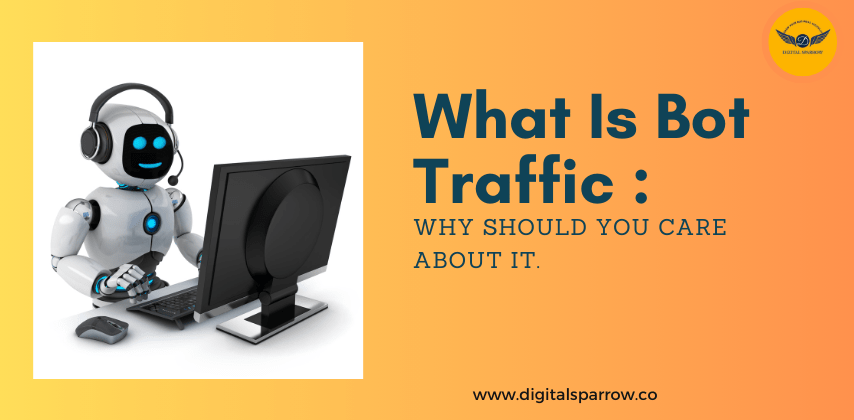Introduction
In the age of digital dominance, web traffic is the lifeblood of online businesses. It fuels growth, drives revenue, and determines the success of your online presence. However, not all web traffic is created equal. Enter bot traffic – a double-edged sword that can either boost your online presence or wreak havoc on your digital operations. In this article, we will delve into the world of bot traffic, understanding what it is, its different types, and why you should care deeply about it.
1. Defining Bot Traffic: Navigating the Digital Frontier
Bot traffic quietly roams the vast expanse of the digital environment, where websites and applications serve as portals to information, entertainment, and commerce. While most individuals have heard of internet bots in some form or another, the complexity and importance of bot traffic are sometimes neglected. In this in-depth examination, we will delve into the realm of bot traffic, dissecting its numerous parts, comprehending its ramifications, and illuminating why it needs our attention.
I. The Essence of Bots
To begin this trip, we must first comprehend the nature of bots. Bots, or robots, are software programmes that perform automated operations via the internet. They are programmed to carry out a variety of tasks, from the commonplace to the complicated, without the need for direct human intervention. Bots exist to improve user experiences, streamline procedures, and, in certain circumstances, serve nefarious intentions. To understand the scope of bot traffic, we must first recognise its three basic categories.
Good Bots: These bots are the unsung heroes of the digital realm. They include search engine crawlers, chatbots, and web monitoring tools. Good bots perform tasks that are typically beneficial, such as indexing web content, answering customer inquiries, and ensuring websites’ functionality.
Bad Bots: As the name suggests, bad bots are the villains of the internet. They operate with nefarious intent, engaging in activities like web scraping, spamming, and initiating Distributed Denial of Service (DDoS) attacks. Bad bots can disrupt website operations, compromise security, and cause financial losses.
Gray Bots: Gray bots occupy a moral gray area, often blurring the lines between helpful and harmful. For example, price comparison bots that scrape e-commerce sites for product information can be considered gray bots. While they may not have malicious intent, they can strain server resources and impact the user experience.
II. The Pervasive Nature of Bot Traffic
Bot traffic is pervasive, with an ever-increasing presence across the digital landscape. Several factors contribute to its ubiquity:
Automation advancements: Advances in automation technologies have simplified the creation and deployment of bots. Bots are growing increasingly complex and difficult to identify as machine learning and artificial intelligence become more prevalent.
Profit Motive: Profit motives are frequently used by bad bots. To make revenue for their operators, they engage in actions such as ad fraud, click fraud, and account takeovers. The promise of financial gain encourages the spread of these bots.
Ease of Deployment: Launching a bot is no longer limited to professional hackers. On the black web, bot-building kits and services are widely available, allowing even inexperienced users to design and deploy dangerous bots.
Diverse Objectives: Bot traffic serves a diverse range of objectives. While some bots aim to scrape data for competitive advantage, others seek to infiltrate systems for espionage or sabotage.
III. The Impact of Bot Traffic
Bot traffic has far-reaching implications that extend beyond the digital realm:
Website Performance: Bad bots can flood websites with requests, causing slowdowns or crashes. This not only irritates users but also harms a website’s search engine ranking and general performance.
Data Security: Malicious bots pose a huge threat to data security. They can exploit weaknesses in websites and applications, resulting in data breaches and the theft of sensitive information.
Analytics Distortion: Bot traffic can skew website analytics, making the data untrustworthy for decision-making. Without precise analytics, organisations may struggle to comprehend user behaviour and make educated decisions about digital initiatives.
Resource Consumption: Bad bots drain server resources, raising hosting costs and potentially causing service outages. This can disrupt corporate operations and have a negative impact on user experience.
Competitive Disadvantage: Gray bots, such as price-scraping bots, can undermine a business’s competitive advantage. By providing competitors with real-time pricing information, these bots erode pricing control and profit margins.
Drive High-Quality Traffic : https://digitalsparrow.co/2-powerful-hacks-to-drive-high-quality-traffic-to-your-blog/
IV. The Imperative of Bot Traffic Management
Given the pervasive and multifaceted nature of bot traffic, managing it is not optional; it’s imperative. Here are some strategies to protect your digital assets:
Robust Security Measures: Implement robust security mechanisms, such as firewalls, intrusion detection systems, and web application firewalls (WAFs), to identify and block harmful bot traffic.
Use Captcha and Behavioral Analysis: Use Captcha systems and behavioural analysis tools to distinguish between humans and bots during registration, login, and critical actions.
Regular software updates: Keep your website and application software, as well as plugins, up to date to address vulnerabilities that bots may exploit.
Continuous Monitoring: Continuously monitor website traffic and use real-time monitoring techniques to discover and block suspicious activity. Examine server logs for trends indicating bot traffic.
Content Delivery Networks (CDNs): Consider employing a Content Delivery Network (CDN) to disperse traffic and absorb the load from malicious bots, boosting website performance and availability.

2. Why Should You Care About Bot Traffic
Now that we understand what bot traffic is, let’s explore why it should be on your radar.
In the fast-paced digital world, where websites and online platforms are integral to businesses and personal interactions, bot traffic has become a pervasive and impactful phenomenon. Understanding why you should care about bot traffic is essential for safeguarding your digital assets, ensuring a seamless user experience, and maintaining the integrity of your online presence.
I. Impact on Website Performance
Bot traffic, particularly bad bots, can degrade the performance of your website or application significantly. These malicious bots can bombard your site with automated queries, slowing it down or even causing it to crash. This not only irritates legitimate users but also harms your search engine rating. Slow-loading pages and frequent downtime can result in higher bounce rates, lower user engagement, and, eventually, revenue loss.
II. Threat to Data Security
One of the most compelling reasons to care about bot traffic is its potential threat to data security. Malicious bots can exploit vulnerabilities in your website or application, leading to data breaches and the theft of sensitive information. This not only damages your reputation but can also expose you to legal and financial repercussions. Protecting your digital assets and user data should be a top priority in the era of rampant cyber threats.
III. Skewing Analytics
Accurate data is the foundation of good digital decision-making. However, bot traffic might distort your website analytics, making it difficult to get relevant information. When your analytics are tainted by bot-generated traffic, you may make inaccurate assumptions about user behaviour, conversion rates, and the efficacy of your digital marketing activities. This can result in erroneous strategy and wasted money.
IV. Resource Consumption
Bad bots consume valuable server resources, increasing hosting costs and potentially causing service interruptions. The computational power required to process bot requests can strain your infrastructure, leading to slower response times for legitimate users. This resource consumption not only impacts your operational efficiency but can also lead to a poor user experience.
V. Competitive Disadvantage
Grey bots, which exist in the moral limbo between good and bad bots, might erode your competitive advantage. Price-scraping bots, for example, might constantly track your product costs and undercut your offerings. This reduces your price control and profit margins, making it difficult to compete in the market.
VI. Legal and Regulatory Compliance
Many industries are subject to legal and regulatory requirements regarding data protection and user privacy. Failure to adequately combat bot traffic may result in violations of these laws and regulations. This can result in penalties, legal action, and reputational damage to your brand. Taking care of bot traffic is not just good business practise, but it is also a legal requirement in many circumstances.
VII. Maintenance of Reputation
Your online reputation is invaluable. When users encounter slow-loading pages, security warnings, or a flood of spammy comments on your website due to bot traffic, it tarnishes your image. Negative experiences can spread through word of mouth and online reviews, causing lasting damage to your brand’s reputation.
3. How to Protect Your Website from Bot Traffic
How to Protect Your Website from Bot Traffic
Protecting your website from bot traffic is essential to maintain performance, security, and data integrity. Here are key strategies to safeguard your digital assets:
I. Implement Robust Security Measures: Invest in security protocols like firewalls and intrusion detection systems to identify and block malicious bot traffic. Web Application Firewalls (WAFs) can be particularly effective in filtering out harmful bots.
II. Rate Limiting: Implement rate limiting on API endpoints to restrict the number of requests a single IP address can make within a specified timeframe. This can help prevent brute force attacks and excessive scraping.
III. User-Agent Analysis: Examine User-Agent strings to identify bots masquerading as legitimate browsers. Implement rules to block or limit access for suspicious User-Agents.
IV. IP Whitelisting/Blacklisting: Maintain lists of trusted IP addresses (whitelisting) and known malicious IP addresses (blacklisting). Configure your server to allow or deny access based on these lists.
V. Geolocation Filtering: Restrict access from specific countries or regions known for high levels of malicious bot activity. Geolocation filtering can help reduce the overall threat level.
VI. Regular Audits: Conduct regular security audits and vulnerability assessments to identify and address weaknesses in your website’s security infrastructure.
Social media marketing for startups https://startupadvice.in/social-media-marketing-for-startups-a-30-days-plan/
Conclusion
Bot traffic is an ever-present force in the digital world, capable of both assisting and undermining your online efforts. Understanding the different sorts of bots and how they could affect your website is critical for effective management. You can provide a better user experience, maintain data security, and protect your online reputation by taking proactive actions to defend your website against dangerous bots. In the digital age, where web traffic is gold, regulating bot traffic is not an option; it is required for long-term online success.


Thank you for your sharing. I am worried that I lack creative ideas. It is your article that makes me full of hope. Thank you. But, I have a question, can you help me?
Thank you for your sharing. I am worried that I lack creative ideas. It is your article that makes me full of hope. Thank you. But, I have a question, can you help me?
I don’t think the title of your article matches the content lol. Just kidding, mainly because I had some doubts after reading the article.